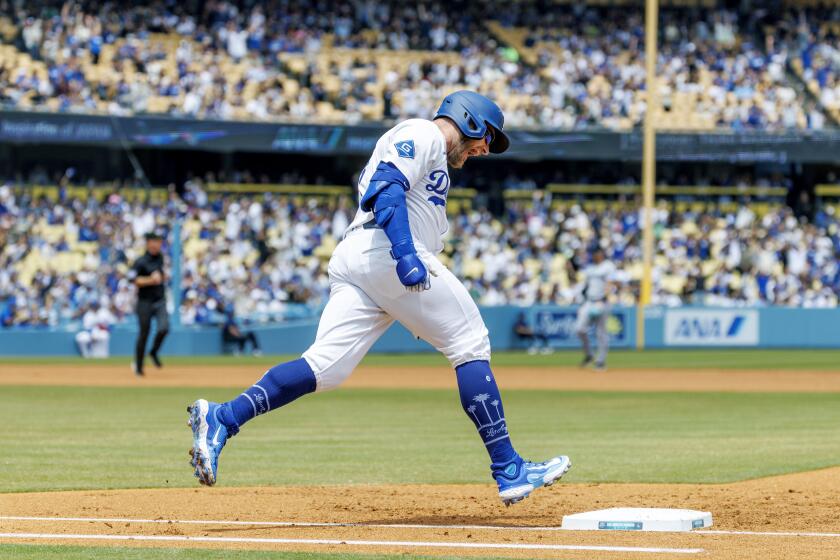L.A. Motto: Todd Help Us
- Share via
Since the early morning of May 15, we have listened to everybody and their seat cushion give an opinion of the Dodgers’ trade of Mike Piazza.
Now, 6 1/2 months later, we finally know how the Dodgers feel.
They think it stunk too.
Tuesday’s acquisition of the New York Mets’ Todd Hundley for Charles Johnson--with two throw-ins--was a bold, potentially winning move by Kevin Malone.
It was also another pie in the face of Fox executive Chase Carey for making the move that has forced this risk.
We’ll get to catcher Hundley later because that’s when we’ll know if this was a good deal--later.
If Hundley can consistently work behind the plate one year after major elbow surgery, with his left-handed power he could fill one of the Dodgers’ two major needs.
Not to mention, make us forget that last year he caught only two more games than his father, Randy.
If Hundley does not work out, kid catchers Paul LoDuca and Angel Pena will be thrown into the frying pan, while Malone goes directly to the fire.
“Sometimes you have to take a chance,” the Dodger general manager admitted.
Of more immediate concern than this trade of the week, however, is the final verdict it renders on the trade of the century.
That little phone call made last May to the Florida Marlins by Carey?
It’s now official. His own lieutenants think he blew it.
After supporting the trade all summer, I also think I blew it.
After Tuesday, can anybody reach any other conclusion?
The Dodgers have now tossed out four of the five players from that deal like defective straw hats.
Johnson and Bobby Bonilla have been traded to the Mets. Jim Eisenreich’s option was not picked up. Manuel Barrios, a minor league pitcher, was waived and immediately reclaimed by the Marlins.
That leaves Gary Sheffield, who this winter has been as much fun as a rush-hour rainstorm.
He said he doesn’t want to play left field, or without Bonilla. This is no big deal, except he has to do both.
Entering the various swaps since the Piazza deal into our college football-proof computer, the outcome is simple:
The Dodgers traded Piazza and third baseman Todd Zeile for Sheffield, Hundley and Mel Rojas.
Would you make that same move today?
Knowing that the Dodgers have not definitely replaced either Piazza or Zeile?
Knowing that even if Piazza was allowed to leave town, they could have taken that $80 million they were going to pay him--plus the extra money they gave Sheffield to come here--to fill their needs?
While still keeping Zeile, who looks like Mike Schmidt compared to Adrian Beltre?
At the time, I thought they received enough for a player who was going to leave at the end of the year anyway.
I was suckered by Bonilla, fooled by Eisenreich, and totally misjudged Johnson, whose defense behind the plate never compensated for his cluelessness when he stood beside it with a bat.
Snookered too was Carey, which will hopefully convince the Hollywood guy to never again cast himself as Branch Rickey.
The difference between this trade and one of Carey’s hot projects--the movie “Titanic”--was that the movie eventually sailed.
The Piazza trade will be forever viewed as concrete shoes.
“Maybe the trade accomplished what the Marlins wanted, but the Dodgers hoped it would help them get into the playoffs, and it didn’t,” said Malone, who had a solid alibi on the day of the crime--he was working in Baltimore.
Malone, however, doesn’t think all was lost.
“What the trade did, it allowed us to do other things,” he said. “I don’t look at it like these players for those players.”
It’s hard for Dodger fans--and embarrassed columnists--to look at it any other way.
Which is what makes this Hundley deal the most important trade since then.
New York took Los Angeles’ home-run hitting catcher.
Los Angeles now has theirs.
Gulp.
Uh, are you guys sure that elbow has recovered?
“He’s back, even better than he was,” said Rick Dempsey, the Dodgers’ new third-base coach who knows the situation better than anyone.
Dempsey was the manager of the Mets’ triple-A club in Norfolk last summer when Hundley was sent down to rehabilitate the elbow.
Dempsey still remembers an August game against Indianapolis when Hundley threw out a runner by five feet in an above-average time of 1.93 seconds.
“That told me the operation was a success,” Dempsey said. “When I was asked if he was healthy, I said yes.”
Hundley was recalled to the major leagues the next day, and never had another chance to show that form again.
Because of Piazza, he spent the rest of the season roaming aimlessly from the outfield to the bench.
Dempsey is still convinced the point has been made.
“Do you know how monumental this trade is for us?” he said. “To have a player like that come in here?”
If he holds up, sure. But in the documented history of rehabilitations, one game is not even one week, much less one month or one season.
Will the elbow survive repeated stress? Will Hundley avoid injuring the shoulder by compensating for the elbow?
And what about when the switch-hitter--who has more power from the left side--bats right-handed? Will the right elbow bother him then?
“We’ve got to be aggressive,” Malone said. “Sure, we could have just stayed with Charles and it might have been fine . . . but we have to try and make things happen.”
While the philosophy should be applauded, the need for such philosophy is regrettable.
Everybody was right. You just don’t trade a Mike Piazza.
*
Bill Plaschke can be reached at bill.plaschke@latimes.com
More to Read
Are you a true-blue fan?
Get our Dodgers Dugout newsletter for insights, news and much more.
You may occasionally receive promotional content from the Los Angeles Times.









